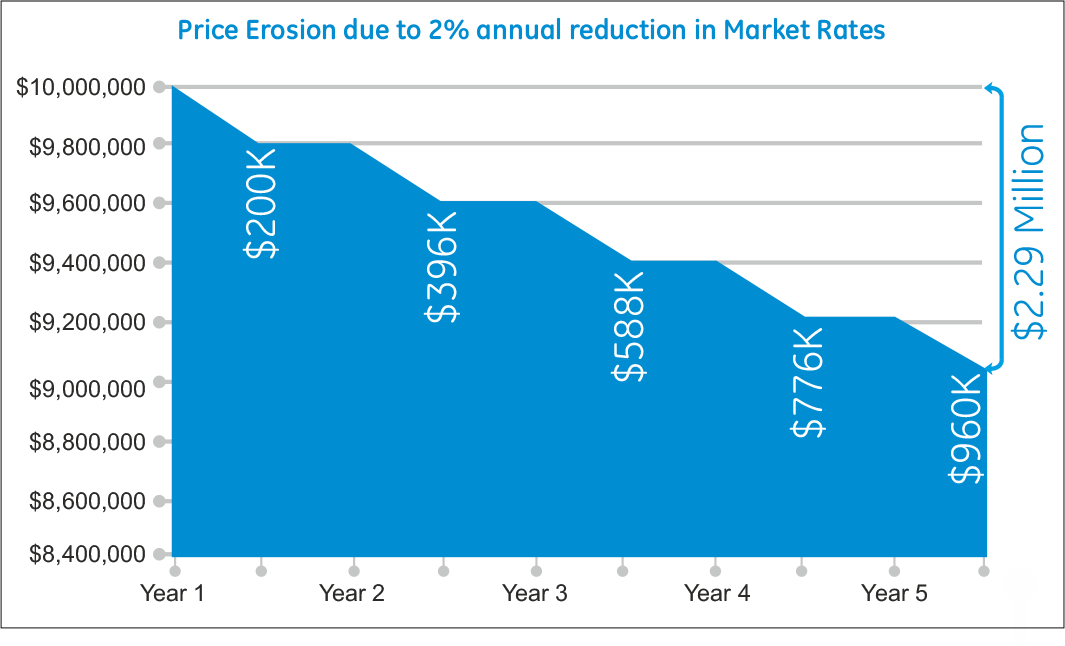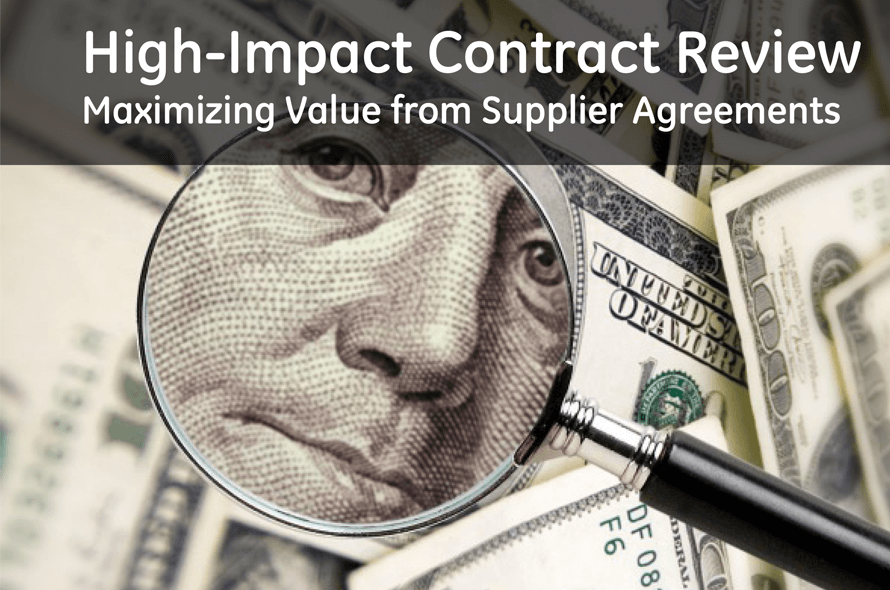Every day enterprise sourcing & procurement professionals strive to reduce costs and increase the value gained on managed spend. It's what we do – and it's a constant battle. But with skill, energy and determination, we often succeed in structuring some excellent deals. Still, we are all painfully aware that a share of our negotiated savings – sometimes a significant share – will leak away.
One major source of leakage can be traced to the implementation of supplier contracts. Consistent and continual evaluation of the roll-out of negotiated agreements, and the concomitant level of compliance with them, is key to realizing the full fruits of your labor.
In particular, the review and close management of large-dollar (i.e. multimillion) contracts, long-term contracts (typically 5 years and above), SLA-linked contracts, as well as contracts in certain categories, such as facilities management, telecommunications and logistics, can deliver big dividends – literally.
Challenges to Contract Adherence
The inability of the supplier and business to adhere to contractual terms, pricing structure and discounts can arise for a variety of reasons – but complexity in the contract itself is often a chief factor. With multiple clauses addressing material markups, multiple rates across geographies, volume rebates, SLAdriven rebates, pricing templates for shortterm projects, penalties for vendor noncompliance, termination costs and separate management fees, complexity abounds.
At the same time, business- or end-users are often not aware of terms, let alone the proper way to best leverage them. Furthermore, contract compliance is frequently not actively tracked and hence it is nearly impossible to manage. A central contract, spanning across multiple geographies and/or business units makes it even more difficult to make a holistic evaluation on the performance of a contract.
Lost Opportunities
- Case in point, a Global Pharma major had a 3 year contract with a Travel Management Company (TMC) across 60 different countries. At the end of the second year a benchmarking exercise revealed that the TMC's rates were 7-15% higher than the market rates varying by country. By completing a negotiation exercise with the TMC, the company was able to extract 7% reduction in their rates by offering a 2 year extension on the contract. The Company was also able to achieve a guaranteed year-on-year savings commitment from the TMC while also restructuring the contract with various new clauses to keep a tab on the contract adherence.

- Short-term projects can be another source of value leakage. The base contract typically stipulates rates and markups for non-recurring, short-term projects, which may either be a fixed fee or time & material based. Business- or end-users may not be aware of the existence of negotiated rates and thus come to separate, typically less advantageous, terms.
- Most contracts typically contain multiple forms of discounts or rebates related to volume of spend or SLA/KPI adherence. Absence of rebate mechanisms, lower rebates and supplier non-compliance can also result in lost savings.
- Invoices submitted by suppliers not infrequently contain deviations (intentional or unintentional) from written contracts, resulting in an organization inadvertently paying excess fees over many years.
- Because a contract is primarily a tool to mitigate risks, a company may focus solely on the legal clauses and fail to consider the clauses on hidden/future charges that also form a part of the contract. For example, a standard charge for termination for convenience clause gives the supplier the right and ability to recoup its investment in securing the supply contract (ex RFPs, etc.). But typically after two years, exceptions aside, suppliers recoup their investment, so the termination charges should only be limited to just such a period.
- Be aware that charge-back expenses can be limited or made the responsibility of the supplier as its cost of doing business. (Note: Expenses during a transition can constitute a significant stream of unplanned charges).
Path to Increased Savings
In a typical fortune 1000 company, active monitoring of contract performance can result in about 5% reduction of overall procurement costs.
Contracts need to be reviewed holistically to identify the costs & hidden charges associated with them. Although SLAs/KPIs help to monitor supplier performance, many contracts are studded with superfluous or redundant metrics. Removing unnecessary SLAs and KPIs will reduce the supplier's administrative overhead; hence the supplier has more room to reduce management and reporting fees. Various overheads like account management fees, third party management fees, site fees etc. can contribute up to 10% of the annual spend within a category which is a great avenue to achieve cost reduction.
Large, multi-million contracts that centralize spend can be leveraged to achieve rebates, even for goods and services that in-and-of themselves are not purchased at scale. In other word, rebates can also be negotiated for any spend above the target spend and should reference negotiated SLAs/KPIs. Establishing a year-on-year annual savings target for a supplier either by cost avoidance or process improvements can also help in effectively reducing the procurement costs. A risk reward mechanism can be set up to incentivize the supplier towards the annual savings target. Also, companies can negotiate for cash backs from a supplier if and when a contract is extended beyond the initial contract period.
Annual benchmarking of prices negotiated in the contract helps companies identify possible overpayments. In the absence of annual benchmarking, rates can be indexed (like labor charges) in the contract, providing a degree of price protection. Some companies tie their spend to inflation indexes, but great care should be taken to identify the correct index, as incorrect indexation over many years may lead to significant overpayments to suppliers.
Expenses for travel and accommodation need to be monitored periodically to effectively manage the hidden costs. It is a good practice to limit or not allow any expenses under a project by introducing such a clause as a part of the contract.
Invoicing errors, especially in categories like logistics, can result in significant overpayment. Periodic audits are a smart way to avoid disputes. Monthly audits of invoice data to check for price non-compliance can help to curb any overpayments beyond the agreed rates.
Analyze spend on the suppliers with whom you have a high-spend contract established.
This process can help identify if there were any maverick spend with a given supplier and also if there are any major opportunities/scope to be consolidated into the master contract.
Finally, check your contract against standard industry rates and practice. Case in point, a tax saving service provider was charging 40% of the incremental tax savings as their fee. The service provider, per the contract was invoicing 80% of its fee upfront, based on confirmed tax savings, and the rest was invoiced on the basis of realized tax savings.
The standard industry practice required no upfront invoicing, the company was able to negotiate their initial invoicing down to 50%, thereby improving their cash flow.
In summary, contract non-compliance can cost companies big time. Companies may inadvertently lose focus on contract implementation, fail to monitor the supplier's performance against the contract and also miss to take advantage of a favorable market movement, all of which can lead to a multitude of lost opportunities for an organization.
But an evaluation of contract compliance and performance that encompasses the following actions can go a long way in maximizing the value from a contract to your organization:
- Evaluate the adherence to rebates – SLA linked or volume linked
- Minimize SLAs/KPIs for managing a supplier efficiently
- Helping to reducing supplier overhead
- Set up maximum limits for the project expenses as a percentage of the total project spend
- Focus on contract implementation with high adoption-rate by end users
- Conduct spend analysis on suppliers with high-spend contracts to identify maverick spending
- Conduct an annual benchmarking exercise irrespective of contract length or category
- Audit the invoice data periodically
- Reach out to industry experts to take advantage of standard best practices within a category to be incorporated into a contract.

